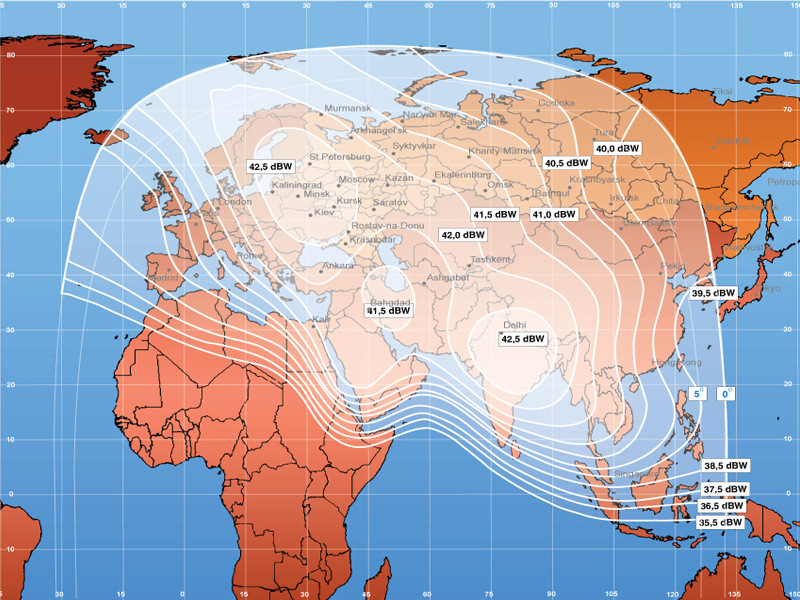Time to talk about the 3.6 GHz band?
There are currently a number of ongoing national consultations in Europe over the future use of the 3.4 to 3.8 GHz band (as the PolicyTracker web-site will attest). Amongst the various noises being made by interested parties, the UMTS Forum are making a strong play for the allocation of spectrum from 3.4 to 3.8 GHz to wireless broadband services. They claim that there is ‘no significant use of the band by satellite’. This is a rather misleading statement.
The 3.4 to 3.8 GHz band is known as the extended C-band by satellite operators and there are many satellites who use these frequencies to deliver broadcast television and other services. It is true that there are no satellite services in the band whose primary target area is Europe (with the exception of Greenland), however that does not mean that the band is not used. There are a wide range of services which are American, Arabic or African in origin for which use in Europe will fall into two main categories:
(1) Reception by professional users, either for re-distribution on cable networks, or re-uplink onto other (Ku-band) satellites for direct to home reception as part of various mulit-channel television packages.
(2) Direct to home/office reception by diaspora of the countries concerned, keen to keep up with news from home.
Of course there will be enthusiasts and others who make a hobby out of receiving obscure satellite services, but these numbers will be very small and (whilst recognising the can of worms that this opens up) arguably of low economic value. In addition there are two-way links between Europe and these other regions for business, telecommunications and other purposes, whose economic value may be more significant.
Whilst it is truer to say that the sub-band 3.4 to 3.6 GHz is very lightly used (and in many countries the decision to hand this over to terrestrial wireless networks has already been taken), it isn’t strictly true to blithely state that there is ‘no significant use’ unless the amount of use has been properly quantified. For professional use, this ought to be relatively straightforward. Cable networks and other multi-channel television head-ends are usually either registered or are well known to authorities. Establishing direct to home use may be more complex. It is highly likely, for example, that the embassy or high commission of a country will have a dish to receive their domestic television programming.
C-band dishes are relatively large and in many countries planning permission may need to be granted for their installation offering a means of identifying how many there are (though I note that one of my neighbours has a 1.8 metre dish installed on the side of their house for reception of South American programmes and has never received a knock from the authorities, despite it having no permission). It therefore ought to be possible to get a feel for how many large dishes are installed and by applying a few simple metrics, be used as a proxy for the number of C-band receivers in use. Unless figures for such use can be reliably established, filling the band with terrestrial wireless broadband services and consequentially eliminating the possibility of receiving C-band satellite services could not possibly be sanctioned by any sane regulatory authority.
But all is not necessarily lost for the terrestrial wireless broadband community. There are solutions to both professional and domestic use. In the case of professional use, the most straightforward means of addressing the problem (and one even suggested by the UMTS forum) is to put an exclusion zone around satellite earth stations. In the UK, for example, there are probably a dozen or so large earth stations (such as the ones at Goonhilly, London Docklands, Crawley Court and Chilworth). With the exception of the one in Docklands, most of these are in relatively sparsely populated areas and the loss of ability to offer services in these areas may not be particularly significant. Much depends upon the size of the exclusion zone that would have to be established around the apposite dishes.
For domestic or semi-professional users, the situation is not as simple to address. Putting exclusion zones around smaller dishes is doubly difficult. Firstly in establishing where they are, and secondly because the dishes themselves being smaller will have a wider field of vision and will receive a weaker signal and thus will be more susceptible to interference. But if the UMTS forum is willing to part with cash to solve the problem, there is a means at hand. Simply downlink all the C-band services visible over Europe (at one of the aforementioned earth stations for example) and re-uplink these onto a Ku-band service with the necessary pan-European coverage. Thus domestic users could install a Ku-band dish instead, leaving the C-band frequencies free to be used for wireless broadband. Managing the rights and access to programmes might be complicated but not beyond the wit of man.

So with a few concessions and a bit of expenditure, the extended C-band might be opened up for wireless broadband services across Europe. But herein lies a small irony. Looking through the list of services available over Europe on such satellites shows that there are a number of transponders dedicated to the provision of satellite Internet access (eg on Yamal 202). C-band is well suited to use for V-SAT terminals in remote locations (and those subject to heavy rainfall) and though the swathe of new superfast Ka-band satellites being launched could provide alternative means of connection, the wider footprint and unique characteristics of C-band satellites might mean they are the most economically efficient means of providing services in the small pockets of Europe that other satellites don’t reach (Greenland for example!) Moreover, satellite operators have not yet begun to think about how else the C-band might be used. It is feasible that it might provide the spectrum needed to introduce more mobile satellite services (with the necessary tweaks to allocation policy at the ITU), or that it could offer feasible mobile broadcasting to reasonable sized handsets to complement terrestrial broadband coverage.

As the nuns at the monastery in Coldingham learnt when the marauding Vikings decided to rampage through their convent (and habits), despite them having cut off their noses to make themselves less attractive, ‘cutting of your nose to spite your face’ is a simple, cautionary tale whose moral may be applicable here too. Handing C-band over to terrestrial wireless broadband services at the expense of what could prove to be innovative and socially beneficial satellite services may prove to be an equally bad judgement call. A sensible, level-headed discussion between terrestrial and satellite operators needs to take place and who knows, maybe they might even find some common ground?